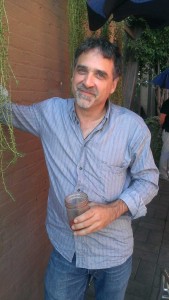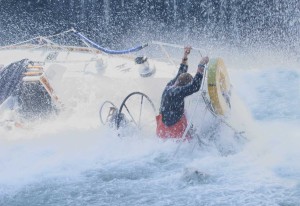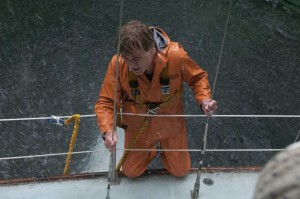
All is Lost is about an unnamed man whose sailing boat gets rammed and almost sunk by a stray cargo container, forcing him into an epic struggle for survival. It stars Robert Redford in a brilliant performance as the ship’s captain, the sole character in what is an all but a silent movie – there are only two sparse lines of dialogue – who fights the elements as he drifts on the vast expanse of the Indian Ocean.
But though the film, directed by J.C. Chandor, appears convincingly set on the open sea, it was actually shot by director of photography Frank DeMarco at Twentieth Century Fox’s Rosarito studio on the coast of Mexico’s Baja Peninsula. The studio has four sound stages with water tanks, including the largest one in the world, which was used by James Cameron for Titanic.
One of the most dramatic episodes in the film takes place when a fierce storm whips up and almost capsizes the boat. The scene was shot on a greenscreen stage, with the vessel placed in the deep part of the Cameron tank. “The boat was rigged so it could tilt, turn and twist,” said DeMarco. “It was like an old-fashioned Hollywood movie,” he added. “We had wind machines, wave machines, water cannons and mad, insane water towers.”
The only high-tech elements were technocranes for overhead shots and greenscreen. “All that mush and water and stuff that was generated was in the foreground, while (visual effects supervisor) Bob Munro did an incredible job putting in the stormy backgrounds with CGI,” explained DeMarco.

Much of the shoot was done with a single camera. “But for the stormy stuff we ran two cameras, one on a technocrane for exteriors and a second one in a waterproof housing because we were getting so buffeted by the artificial waves,” said DeMarco. He and his focus puller wore full wet suits while Redford was in a thin flesh-toned one during the arduous water-drenching scenes which took several days to lens. DeMarco shot with the Arri Alexa camera. “J.C. and I thought about film, but with so many special effects and lots of greenscreen we decided to go digital,” said DeMarco.
Much of the cinematography was done handheld. DeMarco said he was aiming for a “peripheral perspective.” The idea throughout was to stick as much as possible to Redford, “but when he looks around, you also want to look around, to see the same things he sees and experience things contemporaneously the way he experiences them.”
Chandor “had the closest intellectual relationship with Bob, while I had the closest physical relationship,” said DeMarco. “We were always at arm’s length if not closer together. It’s really Bob doing minimal acting, mostly internalized, and the camera reflecting what he’s thinking.” Though some scenes required as many as 10 takes, on average there were only two or three. Because there was almost no dialogue, repetition of lines was not an issue. “Once he got the physical moves down, it was pretty straightforward,” explained DeMarco.
 One of the most challenging and suspenseful scenes involves the main character climbing up to the top of the boat’s 65-foot main mast to try and fix the radio antenna. While Redford did many of his own stunts, in this case the stunt coordinator, Mark Norby, doubled for the actor. “He’s probably in his mid-30s but he learned to walk like he was a 75-year-old man, (Redford is actually 77), and how to move his body that way,” DeMarco noted. Norby climbed the 65-foot-mast, and it was filmed using a technocrane with an 80-foot bucket lift carrying two cameras. The stunt man was also given a still camera, mostly to shoot his feet from the perspective of looking down, which got inserted later.
One of the most challenging and suspenseful scenes involves the main character climbing up to the top of the boat’s 65-foot main mast to try and fix the radio antenna. While Redford did many of his own stunts, in this case the stunt coordinator, Mark Norby, doubled for the actor. “He’s probably in his mid-30s but he learned to walk like he was a 75-year-old man, (Redford is actually 77), and how to move his body that way,” DeMarco noted. Norby climbed the 65-foot-mast, and it was filmed using a technocrane with an 80-foot bucket lift carrying two cameras. The stunt man was also given a still camera, mostly to shoot his feet from the perspective of looking down, which got inserted later.
Meanwhile for Redford, “we built a special 25-foot mast which is still no joke, and put it in hydraulic gimbles, so we could rock that,” DeMarco recalled. Again using a camera mounted on a Technocrane, “we we were able to get right up next to him, and float with him as he was bobbing and weaving with the boat.”
All is Lost had a second cinematographer, Peter Zuccarini, who also worked on Life of Pi, (winner of the Oscar earlier this year for best picture along with an Academy Award for Claudio Miranda for best cinematography), which also featured extensive water photography and CGI. In All is Lost, Zuccarini was the cameraman for a luminescent underwater sequence that shows schools of fish and sharks circling underneath the boat. “It gave us a chance to show what’s happening in the depths of the ocean close to the main character, which he’s completely oblivious to, and it also provided a visual contrast,” said De Marco.
Zuccarini played a role, in a literal sense, during the prep stage of the picture. Using Chandor’s detailed story-boards, “almost the whole movie was pre-shot with a small digital camera and Peter did all the things that Redford did,” DeMarco noted. This was roughly edited so before the shoot began there was a detailed, tangible preview to use as a reference.
DeMarco previously collaborated with Chandor on Margin Call (2011), a fictionalized account of the 2008 financial crisis, following key people at an investment bank over a 24-hour period during the early stages of the meltdown. The DP recently finished Trending Down, a television pilot for Showtime starring Philip Seymour Hoffman and he is currently working on another pilot commissioned by internet retailing colossus Amazon which is starting to venture into television production.





